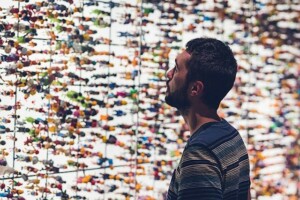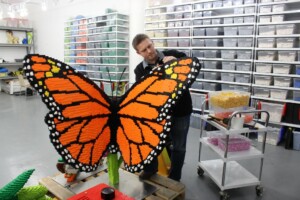How do you prise low-attention-span millennials from their smartphones and engage them with museums and galleries?
Judging by the phenomenal success of Museum Hack, the answer is a fast-paced, fun-packed experience. One that turns the traditional museum tour on its head.
The brainchild of a man who says he never used to like museums, Museum Hack’s apparently subversive and impromptu tours belie their meticulous planning and painstaking attention to detail.

Blooloop spoke to the company’s founder, Nick Gray (left), and dynamic growth marketing manager, Michael Alexis, about the accidental business model that became a runaway success.
A Crazy Romantic Date
“Museum Hack was started from this crazy romantic date that I went on. A woman took me to the Metropolitan Museum of Art in New York City, ” says Gray.
He was, at that point, not a museum person. “I didn’t like museums. And, then, she brought me there and she did something special. She took me on a private tour, showing me things that she liked, that she was excited about. I saw furniture, sculptures, paintings, and was like: ‘Whoa, this place is really interesting. I think I want to come back and explore more.’”
Gray began to return to the museum every weekend. Before long, he started doing increasingly popular tours for his friends where he would show them his favourite exhibits.
“I never really wanted to make it into a business, I really struggled charging.”
It wasn’t until a blogger wrote about his tours three and a half years ago that the idea really took off. The next day, well over a thousand people had emailed him, wanting to join a tour.
”My email inbox flooded, and I had to recruit my friends to help me out. And, that’s where it started.”
Subverting the Snooze Fest
The tours showcase methods usually employed to engage children. By re-imagining the conventional tour format for a lower boredom threshold, Gray has found a way to subvert the potential snooze fest and turn reluctant visitors into enthusiastic participants.
At the outset, the audience for Gray’s tours was his friends: New Yorkers between 21 and 40. Subsequently, the business has been recognised, as Gray puts it, as “the best millennial museum company out there.”
But, says Gray, this isn’t a prescriptive demographic: “We also find that Boomers and Gen-Xers with a millennial frame of mind, people with a shorter attention span who want things to move faster, like it just as much.”
Alexis: “We love what a lot of museums do, and often the way that they present their own tours isn’t broken, it’s just broken for the upcoming millennium generation who want something a little bit faster paced and a different kind of engagement. We’re competing with their cell phones where they can quickly jump onto Facebook or Snapchat. So we re-imagine the adult museum experience, and to us that means putting it in its best light, it’s most adjustable form for that group.”
In the Wrong Place
The tours are clearly unconventional from the outset. Gray explains: “At the beginning of the tour, we’ll say. ‘Welcome to the Metropolitan Museum of Art. This is an amazing place. If you came here for a very high level tour, then you’re in the wrong place, because I’m going to show you my favourite things, the things I’m excited about, the things I’m passionate about.'”

“So we’re setting those expectations right at the very beginning of the tour, and being very up front about what they should expect.
“Because our guides are so focused, it’s important to them that the visitors are very involved, that it’s not just us lecturing them, but that they’re thinking, asking questions, that it’s a group dynamic. It’s an active tour, ” he says.
Fast and Furious
Michael Alexis adds: “Every tour starts high energy. We have everyone gather at a common meeting point. Once it hits time the guide will have everybody hold out their hand in the middle. Then they go down on ‘Mu…’, up on ‘…seum’: ‘Museum’ in a cheer. As soon as that’s done, they bolt into the gallery. from then on the guests literally have to rush to keep up. This means that right from the get-go, it’s this high energy thing.
“And, instead of looking at the most famous pieces, the most expensive pieces, we take people on a tour that our guides find most interesting, so it’s customised for each group.”

“We tell a lot of stories; often they may involve something like affairs or murder, or something sexy and snazzy to grab people’s attention. We also do a bunch of activities in the galleries, such as ‘Matchmaker. Matchmaker’ is where people have to find two pieces of art where the subjects art would be in love. They then come up with a back-story for it.
Museum Hack and Diverse Niches
“And then there’s another one that would be the ‘Yearbook Game’, where your guide gives you a clue, something like ‘Voted worst haircut’, and then you find the piece of art in that gallery where somebody had a pretty bad haircut, and you take a photo of it, to share with the group, and there are prizes.”
Since their beginnings, while still appealing to the millennial demographic, the tours have expanded to fill a number of diverse niches.
Alexis:; “We have a bachelorette party tour, we have themed tours, like ‘Badass Bitches of the Met’, which is a really positive spin on feminism, celebrating the women in art who weren’t given credit in their own time. We also have one called ‘Big Gay Met’, so some of the groups tend to be a little bit more homogenous.”
Fine (Art) Tuning
The Museum Hack tours may appear to be impromptu exercises in a subversive reshaping of the form. However, their success reflects a capacity for painstaking fine-tuning and attention to detail.
Occasionally, people attend without knowing quite what to expect, and it transpires that the tour is not a great fit for them. The guides make a special effort in these cases to engage them, including them in activities. There are a number of techniques that Gray has developed to ensure the tours run smoothly.
Firstly, participants are asked to turn up fifteen minutes early so that, in the guise of small talk, the guide can find out what kinds of objects they like to look at, and what they are expecting.
Gray explains: “The guide kind of feels them out, and then customises the route.”
Secondly, when purchasing their ticket, participants are asked whether they have ever visited this museum before.
“Knowing that can help us, ” Gray says: “Half our visitors haven’t, but if they have we ask ‘What did you like last time?’ Even if they’ve been there 25 times, I take it as a personal challenge to show them something they’ve never seen before.”

Renegades Among the Rembrandts
Has Gray subverted the museum tour, or simply lifted it, improving it beyond recognition? He concedes: “We definitely started by being very subversive. Our policy was to ask for forgiveness, not permission.”
Alexis agrees. “When the company first started, it was marketed a little bit differently; we weren’t ‘Museum Hack’, we were ‘Hack the Met’, and it was really pretty renegade.”
Currently, Museum Hack does regular tours at four museums in three cities: the Metropolitan Museum of Art, and the Natural History Museum in New York, the National Gallery of Art in DC and the De Young Fine Arts Museum in San Fransisco. Private tours can also be commissioned anywhere.
“Examples of museums and other locations we’ve hacked in New York include the Brooklyn Museum, The Rubin, the Fraunces Tavern, where George Washington and his crew would go for drinks and to make battle strategies etc., ” says Alexis. “We also do the tours of the battle ship USS Hornet in San Francisco.”
Team-Building Reimagined
Company team-building tours are a growing phenomenon.
“A big part of our business is company team-building tours, where the demographics are all over the map, ” says Alexis. “An example would be that Google or Facebook or Etsy, all big companies we’ve worked with, might bring 10 or 20 or even 100 people to the museum with us, and then it’s really quite a range of ages and professions.”
The team-building tours were an unplanned departure: initially, the idea was to stick to public tours, with perhaps several versions.
“But then the guests that came on tour, actually asked us ‘hey, could we bring our company along to this as well?’. And that is rewarding because these peoples aren’t just coming for entertainment, but because they have a challenge in their organisation, and it’s really awesome to watch them get through that.”
“It’s huge, ” agrees Gray. “Businesses send us their staff for workshops and training, and we do those at three or four further museums.”

Gamekeeper turned Poacher?
Having taken advantage of the training offering, several museums are now adopting the techniques of Museum Hack, making them part of their programme. Museum Hack worked recently with San Francisco’s MOMA (Museum of Modern Art) to create an audio tour for them. Other venues are keen to bring Museum Hack to their attraction.
“Of course, we can only do so many museums at a time, ” says Alexis. “Museum Hack is growing as fast as it can. Others are trying to adapt and figure it out on their own.”
There have been wrinkles to iron out on the way.
Alexis says, “At the outset, people were encouraged to have a few drinks before coming. Some people could get carried away. I wasn’t around at that time but my understanding is that, while it was meant in good fun, some would have a few too many drinks and heckle the guide, or otherwise cause problems. So we don’t really encourage that anymore, although we do have wine on some of the tours. We do VIP tours and include a wine stop. Usually the bachelorette parties and the teambuilding tours have wine as well.”
.jpg)
Can Museum Hack stay Subversive?
Gray adds: “We’ve served more than 15, 000 people so, of course, we’re going to have bad experiences. We tend to hire very attractive, charismatic staff, and occasionally people misinterpret that. So, we do a bit of training for our staff on how to deal with that, and how we can support them.”
Is the success of the Museum Hack approach in danger of making it no longer subversive but part of the mainstream?
Alexis considers this. “First, we really believe in innovation and looking at things in new ways. So if you imagine 5 or 10 years in the future where the Museum Hack style has become so prolific that everyone’s doing it, by that time we’ll have moved on to a new form ourselves.”
“I don’t think it will go that way, because we appeal to a very specific audience, the type that doesn’t mind hearing the word ‘Fuck’ on the tour. The line on our website says ‘not your grandmother’s museum tour’. I think there’ll always be space for both.”

Breaking the Tradition Not the Rules
Initially, the museums’ response to the Museum Hack tours was guarded.
Gray says: “I think at the beginning they thought that we were hooligans. They didn’t know what to make of us. Now, we have a little bit of a reputation within the museum world. We know which departments to work with, whom to talk to. The big thing is we don’t break the rules necessarily, we break the tradition. And, so one of those might be ‘adults aren’t supposed to sit on the ground to talk about things’, so – OK: we’ll do that.”
The tours are, for the most part, becoming an acceptable and often welcome alternative to their more conventional counterparts, but could museums feel threatened by Museum Hack’s success?
“ I think so, sure. Yeah. The museum could think that for us to be successful, it means they’re not doing a good job.”
Nevertheless, he says that rather than replacing conventional museum tours, Museum Hack is supplementing them, to reach a new type of audience:
“This is the big thing: we think there’s a much bigger audience out there, that’s not currently going to museums. We think there is a huge number of people who, no matter what the museums say, won’t listen because they think they don’t like museums. That’s who we’re trying to reach. We’re trying to convert this whole new type of audience, say ‘look, you can have fun in a museum. Adults, we should be going to these places, they’re encyclopaedic collections of our history.’”

Museum Hack Here, There, Everywhere
Expansion is on the cards for the future.
“We would like Museum Hack to expand abroad. We’d love to come to London, but it’s a very expensive, difficult process, ” says Gray. “We’re not a billion dollar company. This isn’t a get-rich-quick startup thing. So we’re trying to be very careful in our growth to make sure it’s managed and sustainable.
“In five to ten years, I hope we’re bigger, and I hope we’re more global. I hope we’re changing how adults experience museum tours. And on a much larger scale, I hope that we’re helping people fall in love with these cultural institutions that we love.”
The biggest convert of all is Gray himself. He even has a favourite artefact.
“It’s at the Metropolitan Museum of Art and it’s called ‘Fragments of a Queen’s face’. I love that, it’s awesome, ” he says, adding, with a Museum Hack twist of perspective: “It’s small. It’s very stealable.”















